Late Summer Viewing, part 1
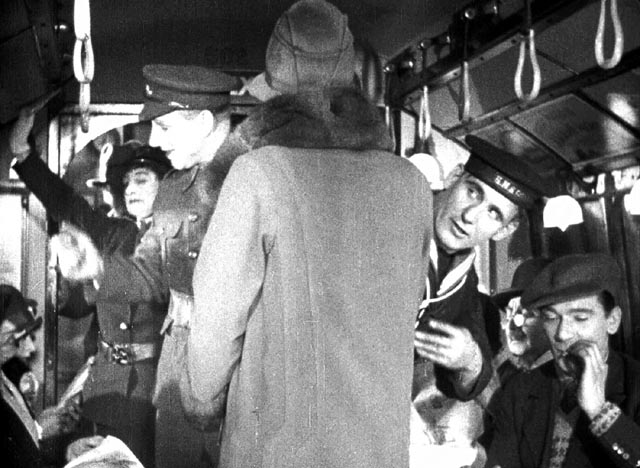
Falling behind again! Things have been hectic lately – working on a documentary which has turned out to be bigger than expected and is now way overdue, plus starting a new project with a tight deadline, I haven’t had a lot of time to write down notes on what I’ve been watching the past couple of months. So what follow here are some brief comments on some of the disks I’ve been using to avoid work.
Being multi-region capable tends to increase both temptation and pressure and I often find myself suspended, as it were, between the latest offerings of Criterion in the U.S. and the BFI in England. In the past few months, my Criterion viewing has tended to consist of revisiting familiar films on Blu-ray, while the BFI titles are all new to me.
Criterion

Being John Malkovich (1999): Spike Jonze’s debut feature, with a highly original script by Charles Kaufman, may not seem as radical today as when it first came out, but what I noticed on this viewing was that it’s a much darker film than I first thought, with a very bleak view of desire – and emotional need – which now overshadows the wildly surreal comedy arising from the concept of a portal into the mind of actor John Malkovich which sad-sack puppeteer John Cusack starts charging people admission to access.

The Game (1997): David Fincher’s third feature is highly polished entertainment based on a ridiculously implausible idea; bored investor Michael Douglas signs up for a life-changing experience which turns out to be a paranoid, conspiratorial nightmare, stripping him of everything he owns and smashing his tightly buttoned-down sense of himself. It’s fast and exciting, but when it becomes apparent that pretty much everyone in San Francisco (and everywhere else he goes) is a part of the conspiracy and it all leads like clockwork to a climax which is so convoluted that it’s impossible to buy the planning that must have gone into it, it reveals itself as moralizing allegory rather than reality-based thriller.

Lord of the Flies (1963): theatre director Peter Brook took a group of adolescent boys to a remote spot in Puerto Rico and turned them loose on the beach and in the jungle to act out William Golding’s allegory of innate human evil. Shot verite style, with an absence of the mannerisms often found in child actors, the film is a gritty, dark, often technically quite crude, attack on the idea of innocence. Like many people, I first read the book when I was the kids’ age and envisioned myself as one of the good guys who survive the descent into savagery. For all its limitations as a piece of filmmaking, Brook’s movie captures the spirit of the book very well.
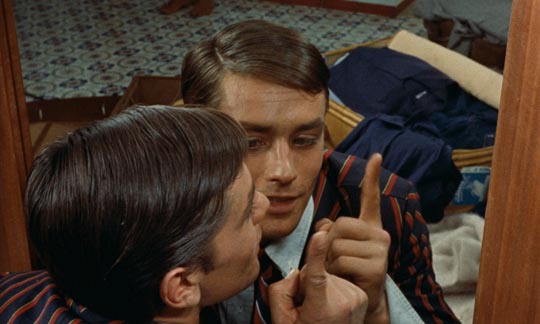
Purple Noon (Plein Soleil, 1960): Rene Clement’s coolly matter-of-fact adaptation of Patricia Highsmith’s The Talented Mr. Ripley is vastly superior to Anthony Minghella’s bloated, mis-cast version from 1999, and along with Hitchcock’s Strangers On a Train and Wenders’ The American Friend (from Ripley’s Game), represents the closest movies have come to capturing the author’s style and world-view. Alain Delon became a star with his performance of the blithe sociopath who, having failed to persuade the bored son of a wealthy American to return home, decides to kill the guy and take his identity. The film rests on Delon’s ability to improvise moment to moment as events keep interfering with his plans.

Repo Man (1984): Alex Cox’s debut feature had the distinction of capturing the essence of punk culture from the inside, a funny, warped, irreverent thumb in the eye of the mainstream which manages to combine cynical comedy, engaging characters, and an absurdly convincing conspiracy involving the radioactive body of an alien stolen from Area 51. The great Harry Dean Stanton has never been better than here as the dead serious proponent of the repo man’s code, and come to that Emilio Estevez has never been better than as the snotty Otto who gets drawn into the repo life mostly because he has nothing better to do. The dialogue and production design are witty as hell, and the soundtrack is a compendium of what was best in punk at the time.
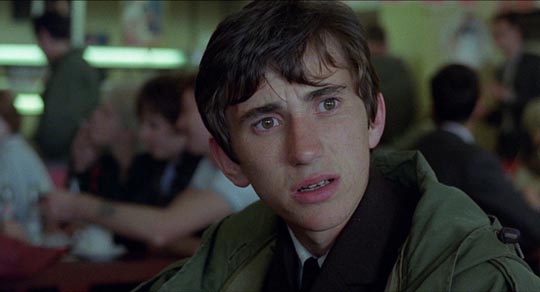
Quadrophenia (1979): like Repo Man, this “adaptation” of Pete Townshend’s rock masterpiece captures a particular social and cultural moment with absolute authenticity. An English Rebel Without a Cause, Franc Roddam’s first (and best) feature dissects the agonizing process of finding a sense of one’s own identity, with Jimmy (a brilliant performance from Phil Daniels – but then the entire cast is terrific) investing everything in the external trappings of the group, in this case Mods, only to find that it leaves him hollow and vulnerable. The Blu-ray does justice to the richly textured images (except for a couple of excessively grainy night shots with the blacks swamped by an ugly red flare), the convincing period detail, and the strength and nuance of The Who’s music (in the original 2.0 stereo mix as well as a new 5.1 remix). Roddam’s concern for realism results in impressive large-scale set-pieces like the powerful Brighton riot as well as small telling details (like the awful cafe food), and he resists the temptation to turn the adults into caricatures (it’s easy to sympathize with Jimmy’s exasperated parents, Michael Elphick and Kate Williams). One of the finest British features ever made.

Menschen am Sonntag (People On Sunday, 1930): this vibrant collaborative effort – Billy Wilder, Edgar G. Ulmer, Robert Siodmak, Eugen Schufftan, Fred Zinneman – provides a fascinating glimpse of life in the capital of late-Weimar Germany, following two couples on a summer Sunday trip to the lake just outside the city; relationships shift and change, feelings are hurt and repaired, and the rhythms of urban life are captured beautifully just three years before Hitler took power.
The BFI

Emil und die Detektive (Emil and the Detectives, 1931): adapted (by Billy Wilder, with early work done by Emeric Pressburger) from an internationally popular children’s novel by Erich Kastner, this was the first of many film and television versions and it makes a great complement for Menschen am Sonntag. The story of Emil, sent to visit his grandmother in Berlin only to have all his money stolen by a creepy man on the train, was largely shot on the streets of the city with a large and completely natural cast of children, so there’s a fascinating documentary element added to the narrative of kids’ intelligence and ingenuity. The naturalism is offset by a remarkably rendered dream sequence which uses all the expressive powers of silent film technique, and Fritz Rasp, an actor popular with Lang and Pabst, creates a deeply disturbing villain. Made just four years later, the first British version (directed by Milton Rosmer and included on the region 2 DVD) is an almost shot-for-shot remake set in London, but it drops a couple of key story elements and its sense of the British metropolis isn’t as richly developed as the Berlin of Gerhard Lamprecht’s original.
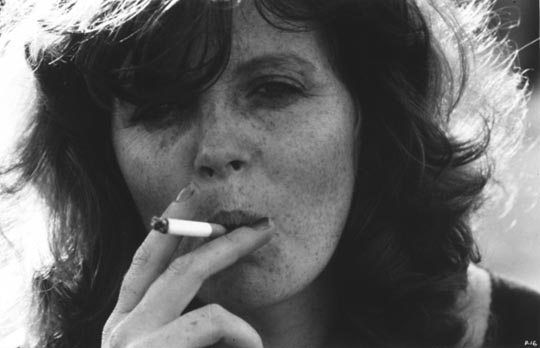
Prostitute (1980): Tony Garnett, long-time producer for Ken Loach, turned to directing using Loach’s documentary-based approach in this depiction of the lives of prostitutes in Birmingham and London, combining the dramatized story of Sandra (Eleanor Forsythe), a working girl who eventually heads for London and tries to become a higher class call girl, with the efforts of social worker Louise (Kate Crutchley) to organize Birmingham’s prostitutes to get laws changed and reduce police harassment. The film is an earnest, socially conscious time capsule of attitudes towards gender and sexuality, unsentimental and stripped of the kind of movie glamour often imposed on the subject.

Maitresse (1976): Barbet Schroeder’s third feature takes a very different approach to prostitution, visually lush thanks to Nestor Almendros’ very polished cinematography, and deliberately symbolic rather than grittily realist in its analysis of sexuality, desire, and gender issues. After a pair of petty crooks break into a Parisian apartment and discover the workplace of a dominatrix, one of the men gets involved with the woman. The apartment is split into two levels, a “normal” living space upstairs and the “dungeon” below. The woman, Ariane, moves freely between the two, while the man, Olivier, tries to enjoy life upstairs while being simultaneously curious and troubled about her work downstairs. The role-playing of the masochistic fantasies is oddly asexual, rooted more in a complex combination of submission and power – this is not about Ariane’s desire or sadistic pleasure; she is actually the servant of her clients’ desires and their performed acts of abasement and submission actually put them in the controlling position.

But what Olivier sees is the dominant woman and this undermines his own sense of masculinity, forcing him to greater assertions of his own dominance, which paradoxically lose him the warm, comfortable emotional and sexual connection he has with Ariane. Schroeder fumbles the ending, trying for something which establishes a new balance between the two, but the film is an interesting depiction of the multiple physical, emotional and psychological layers implicit in relations between the sexes and the performances of the two leads carry the director’s intentions effortlessly: a very young Gerard Depardieu as Olivier and a charming Bulle Ogier, who combines a great deal of delicate sweetness with complete self-assurance as Ariane.

Underground (1928): Anthony Asquith was only 26 when he made this, his first official feature (the previous year’s Shooting Stars was credited to A.V. Bramble) and it’s a remarkable piece of work. The director only made four silent features, but the two currently available (this and A Cottage on Dartmoor [1929]) mark him as easily Hitchcock’s cinematic equal in the final days before the arrival of sound. What starts out as a romantic comedy involving four people, two men and two women, who meet by chance on London’s Underground, shifts gradually into darker areas of jealousy, anger and finally violence, with a final act which is reminiscent of Lang both visually and in its moral ambiguity. The tonal shifts are handled with great skill, making the film constantly surprising and unpredictable (a trait it shares with A Cottage on Dartmoor, also available from the BFI and from Kino in region 1).
The war

The Way to the Stars (1945): after his remarkable silent films, Asquith’s work changed radically with the coming of sound. His best later work consists of adaptations of plays (The Importance of Being Earnest, Pygmalion, The Winslow Boy, The Browning Version), but it seems that once his characters could speak, he lost all interest in visual storytelling. The later work gives primacy to the script, the camera merely there to record what’s being said. Perhaps that’s too harsh, as many of his talkies exhibit a high level of craft in their staging, camera use and editing; it’s just that the visual clearly now serves the text rather than embodies it, as it did in the silents. The Way to the Stars is one of several collaborations between Asquith and playwright Terence Rattigan, this one an original script based on Rattigan’s own wartime experiences in the RAF. Although the story of various flyers – British and American – based at an airfield in southern England has many conventional elements, the characters are well-drawn and the ways in which focus shifts from one to another as the years pass and people arrive and depart, and sometimes turn up again, has a convincing feel for the transience and insecurity of lives controlled by inexorable outside forces. The cast is excellent (including Trevor Howard in his first role and a very young Jean Simmons, along with stalwarts John Mills and Michael Redgrave). Rendered with that typical English laconic emotional restraint, the film generates deep feelings and ends up being very moving without ever becoming sentimental.
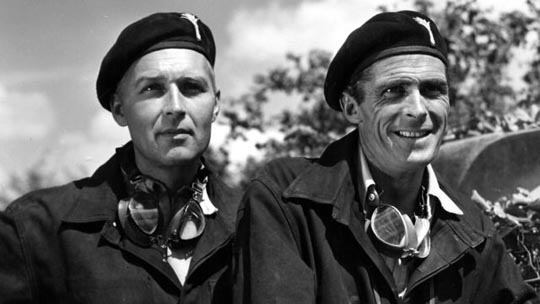
They Were Not Divided (1950): Terence Young was one of those workmanlike directors whose filmography exhibits little in the way of a consistent personality – comedies and costume films are scattered among the preponderance of adventures and thrillers – and he really only achieved prominence when he got to introduce James Bond in Dr. No (1962). His fourth feature, They Were Not Divided, is a fairly routine WW2 story based on the experiences of the Welsh Guards, a tank regiment which arrived in France just after D-Day and fought through northern Europe in the Ardennes and as part of Operation Market Garden. But before we get there, the film deals with years of training in England, with the unit waiting to be deployed. There’s nothing new or remarkable here, but documentary footage is well integrated and Young stages the tank action efficiently.

Cockleshell Heroes (1955): actor Jose Ferrer directed only a handful of movies, and they’re an odd selection, ranging from I Accuse! (about the Dreyfuss Affair) to Return to Peyton Place. His second feature is a well-executed “mission” narrative based on an actual event, performed by one of those casts packed with familiar British character actors. A newly minted officer is given command of a unit of Royal Marines in order to carry out his plan of sending saboteurs up the river to Bordeaux in canoes to plant mines on heavily protected cargo ships which can’t be bombed from the air. His loose, very un-military methods run afoul of career officer Trevor Howard who is assigned as his second-in-command; naturally the men eventually learn to respect each other and their complementary strengths are needed to carry out the dangerous mission. It would take another half decade for this type of story to evolve from a sincere documentary-like approach into the big action fantasies of the ’60s like The Guns of Navarone and The Dirty Dozen.
Comments